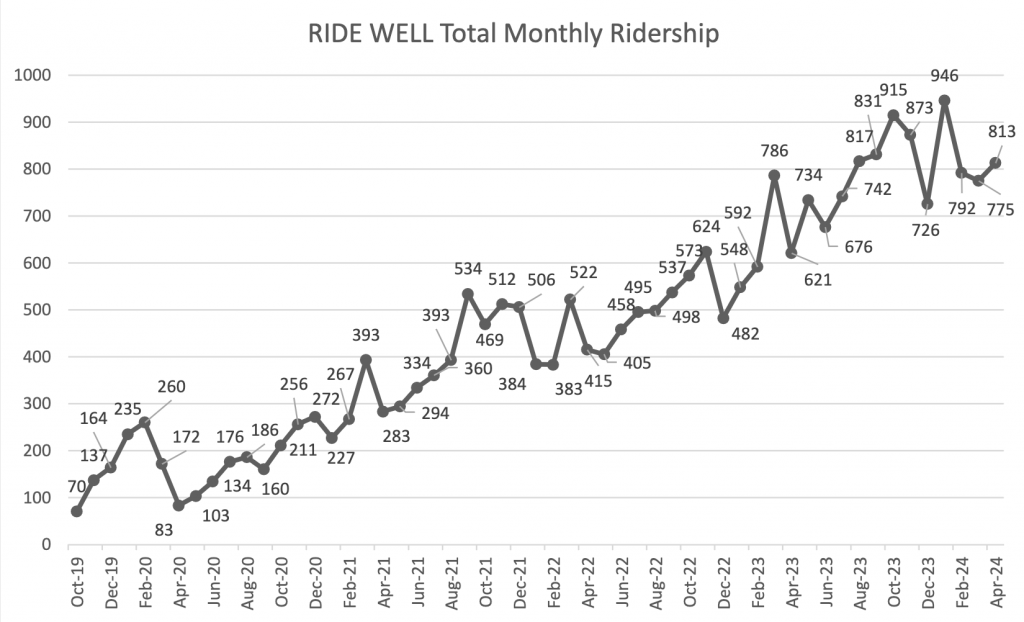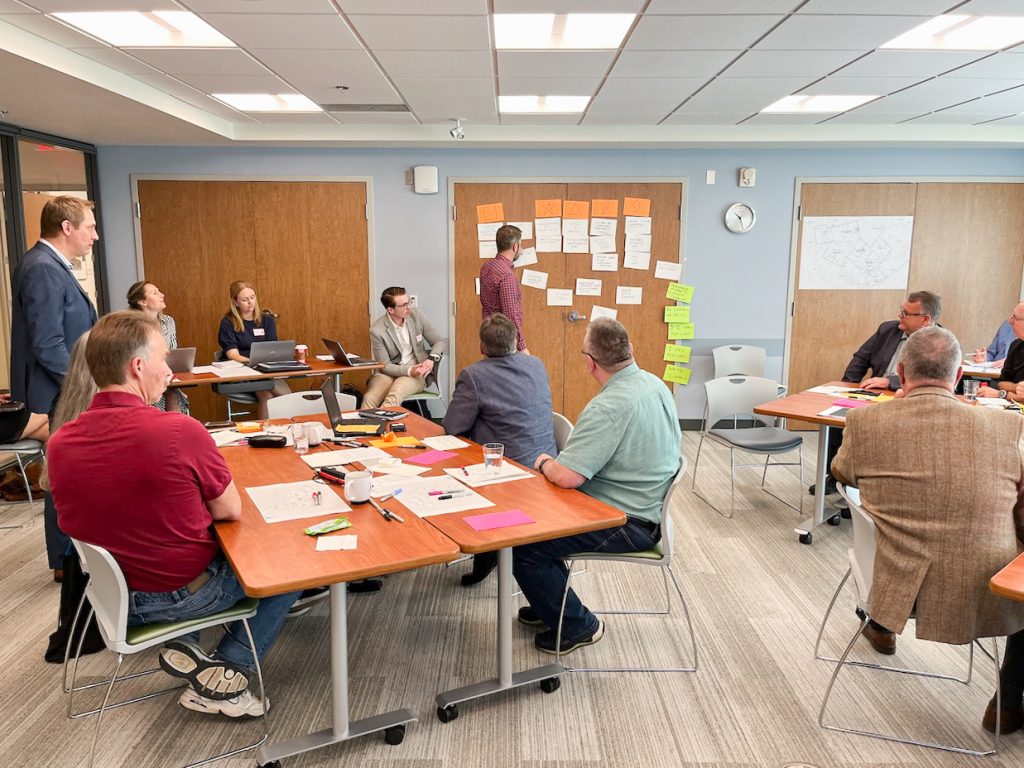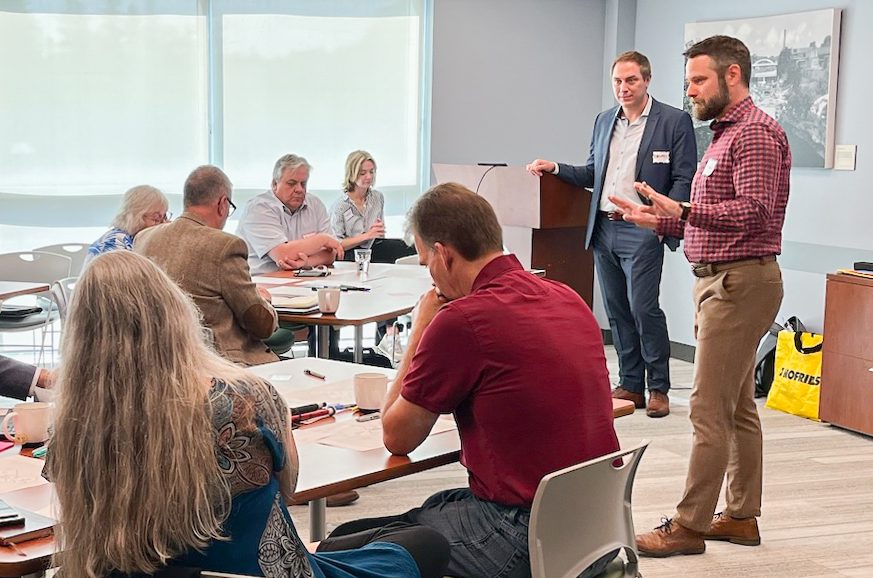WELLINGTON COUNTY – Mapleton resident Dorothy Keller says if it wasn’t for Wellington County’s Ride Well service, she would cry.
Keller has used the county’s ride-sharing service, operated by Waterloo-based Ride Co with independent contractors driving their own vehicles, for several years to get her 76-year-old husband Ronald Keller to medical appointments.
“I think it’s an absolute great service,” Patti Denney told the Advertiser.
Sharing rides with others can be off-putting, she said, but the regular faces of the “respectful and polite” drivers are comforting.
Denney has used Ride Well for the past six months, after hearing about it from a friend.
Getting to work at a nursing home, travelling to medical appointments in Guelph and transporting groceries are all made easier and more cost-effective by the service, she said.
Whereas getting to an appointment in Guelph from Fergus with a taxi would cost around $60, according to Denney, she can make the trip for just $12.50 through Ride Well.
Funding from the province to the tune of $500,000 got Ride Well’s wheels turning in 2019, for a four-year pilot program.
The program was later extended and, in March, the county received an additional $230,000 to see the pilot through to early 2025.
The ride-sharing model has stayed the same, but its purpose has shifted solely from getting people to/from work, to a service connecting residents throughout the county to each other, as well as medical appointments and schools, and beyond the county’s borders, into Guelph.
According to a consultant’s report, 40% of those using Ride Well at least thrice weekly since January were getting to work, another 15% were going to medical appointments, and another 8% of riders — accounting for 359 rides alone between January and March this year, largely for youth accessing education — came from the Community Resource Centre of North and Centre Wellington.
Economic development committee chair Jeff Duncan said the service is “entirely different” when it comes to the degree of funding, the number of people using it, and how it operates.
As of July 1, the service will grow to five cars from four, and adopt a zone-based model placing dedicated cars in north, central and south zones.
Owen Sound’s Guelph Owen Sound Transportation bus, with scheduled stops throughout the county and into Guelph, has already been integrated into Ride Well.
Popular ride-hailing service Uber is also being integrated in the RideCo/Ride Well system to address overcapacity issues with the service – roughly 20 per cent of ride requests cannot be fulfilled – and cancellations from RideCo, such as when a driver is sick.
Both Keller and Denney told the Advertiser of occasional difficulties booking rides.
“I can’t phone Ride Well up and say ‘I need a ride;’ you have to book it ahead of time,” Keller said, adding, “I wish they had longer hours.”
Denney said she has missed a medical appointment because of a lack of available cars.
“I accept it; they’re busy,” she said.
What initially began with fewer than 100 trips per month gradually increased to a few hundred by 2021.
Despite a drop in ridership during the pandemic, use rebounded in more recent years, nearing a peak of 950 rides in January this year.

County of Wellington
But the county is nearing a crossroads with fall budget planning, provincial funds running out, and the pilot set to expire in March.
In Duncan’s words: “Is there a (budget) line for Ride Well, or is there not?”
With five months left until budget time, two of which are recessed for the summer, the pressure is on for county politicians to answer a fundamental and lingering question of whether to hit the brakes on Ride Well, or put gas in the tank.
At the Wellington County library branch in downtown Fergus on May 16, a meeting room thrummed with the exchange of ideas and debate.
Dillon Consulting community engager Morgan Boyco jotted some of the ideas from county councillors on an easel, as Dillon transit planner Dennis Kar provided expertise on transit options.
Ride Well could look “drastically different” come 2025, or it could look exactly the same, Kar said.
The choice was for councillors to make as they compared notes on the needs and issues, as they saw them, for a county transit service.
On the other side of the room, ideas were put to paper and categorized into columns.
A 30-page Dillion report presented in March to the economic development committee presented a list of recommendations for the service into 2025.
“Initially, we were thinking we’re going to just … pound away at the different recommendations,” Duncan told the Advertiser.
But as discussion wore on, Duncan said, it became obvious members were “uncomfortable” with trying to hash everything out at the committee level, leading to last week’s workshop.
Concerns that rose to the surface included people’s awareness of the service, linking different services, accessibility, financial sustainability, community building, timing of trips, and reliable and equitable access.
Two “strategic directions” crystallized: access and equity, and financial sustainability. And the key questions: who should Ride Well serve, and how?
Strained resources, a lack of availability, no long-term solutions, and possibly a need to revamp the service model are challenges for the county to contend with, councillors heard.
There will be trade-offs in tailoring the service to who needs it most, and though transit services never turn a profit, Kar said council will need to make the best use of available public dollars.
The 2024 program cost was budgeted at around $439,000. Of that total, provincial tax dollars account for $125,000; county taxpayers are contributing $226,000; and fare revenue is pegged at $88,000.
(Those figures don’t include the March influx of $230,000 from the province, which must be spent by the county between now and when the pilot ends.)
Heavily subsidized fares mean travellers are currently paying between $5 and $40 per trip. However fares are expected to increase if the service continues beyond March 2025.
Though fares have remained consistent throughout the pilot, in actuality the county now pays a higher hourly rate for the service than it did in 2019. The increase to $42 from $30 per hour — to address inflation and driver recruitment and retention — hasn’t been passed on to travellers.
So, how does a group of 12 councillors with varying political positions and personal beliefs come up with a recipe for a transit system serving a growing population of more than 100,000 people spread across 2,665 square kilometres?
A pair of consultants, hours of brainstorming, a number of colourful sticky notes, and a list of ingredients, it turns out.

Photo by Jordan Snobelen
On a large TV screen, the consultants considered a mix of ingredients: operating hours, service availability, directness, external travel, and like an outsize anchor of its own, Guelph.
Like a real recipe, adding more of one ingredient influences other ingredients and how those other ingredients respond.
For example, expanding Ride Well’s coverage area may seem like a good thought, but has a potential consequence of making the service less reliable by reducing availability. To combat that, the county would need to spend more money for more drivers and cars, but that has the consequence of making the service less financially sustainable.
Councillors quickly found that equally aligning Ride Well with the two strategic directions that stood out – access and equity and financial sustainability –would be impossible.
“This is very difficult to just prioritize one or the other,” Boyco told the group.
“What are the trade-offs, because that’s what it’s going to come down to,” he added.
Despite “broad agreement” among councillors, county Warden Andy Lennox said, “there’s still this huge tension that we’ve talked about, between the financial sustainability and the access and equity, and those things are not all that compatible.”
“We’re probably going to end up somewhere in between, and how are we going to make those trade-offs … to me that’s been the biggest challenge all along,” the warden added.
“I think the focus now is continuing that access and equity sort of lens, provide everybody a potential option for transit,” Kar said.
Feedback from the meeting will result in a presentation to the county economic development committee, slated for June, suggesting a concept model for the next six months, and will likely include suggestions on how to spend the recent cash influx.
Another presentation is anticipated for the fall to provide councillors with options for Ride Well’s future beyond 2025.




